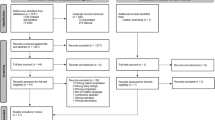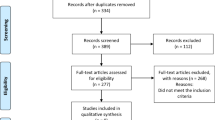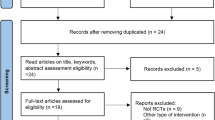Abstract
There is currently limited data on which drug should be used to improve blood pressure (BP) control in patients with resistant hypertension (RH). We performed a systematic review and meta-analysis of published studies evaluating the anti-hypertensive benefit of aldosterone antagonists (AA) as an add-on therapy in patients with RH. A systematic literature search for eligible studies was conducted until June 2014, using literature databases and hand search. Studies were stratified according to controlled vs uncontrolled design and analyzed using random-effect models. We identified 13 eligible studies involving a total of 2640 patients, consisting of 3 randomized controlled trials, and 10 observational studies without a control group. In controlled studies, there was a reduction in mean systolic and diastolic BP of −16.5 (95% confidence interval (CI), −30.0 to −3.0) and −4.1 (95% CI, −7.8 to −0.32) mm Hg, respectively, compared with control. In uncontrolled studies, there was a reduction in mean systolic and diastolic BP of −19.7 (95% CI, −23.2 to −16.2) and −9.1 (95% CI, −10.3 to −7.8) mm Hg, respectively, compared with pre-AA therapy. Subgroup analysis showed that the systolic BP change was more pronounced in patients with baseline systolic BP >150 mm Hg (weighted mean difference (WMD), −23.1 mm Hg) than in patients with ⩽150 mm Hg (WMD, −15.4 mm Hg) (between groups P<0.001), suggesting that the baseline systolic BP was a predictor of the BP response to AA treatment. Furthermore, AA demonstrated a mild increase in serum potassium and creatinine (for both, P<0.001). The findings suggest that AA as an add-on therapy was effective for lowering systolic and diastolic BP in patients with RH.
This is a preview of subscription content, access via your institution
Access options
Subscribe to this journal
Receive 12 digital issues and online access to articles
$119.00 per year
only $9.92 per issue
Buy this article
- Purchase on Springer Link
- Instant access to full article PDF
Prices may be subject to local taxes which are calculated during checkout





Similar content being viewed by others
References
Persell SD . Prevalence of resistant hypertension in the United States, 2003–2008. Hypertension 2011; 57: 1076–1080.
De la Sierra A, Segura J, Banegas JR, Gorostidi M, de la Cruz JJ, Armario P et al. Clinical features of 8295 patients with resistant hypertension classified on the basis of ambulatory blood pressure monitoring. Hypertension 2011; 57: 898–902.
Roberie DR, Elliott WJ . What is the prevalence of resistant hypertension in the United States? Curr Opin Cardiol 2012; 27: 386–391.
Sarafidis PA, Bakris GL . Resistant hypertension: an overview of evaluation and treatment. J Am Coll Cardiol 2008; 52: 1749–1757.
Sander GE, Giles TD . Resistant hypertension: concepts and approach to management. Curr Hypertens Rep 2011; 13: 347–355.
Calhoun DA, Jones D, Textor S, Goff DC, Murphy TP, Toto RD et al. Resistant hypertension: diagnosis, evaluation, and treatment. A scientific statement from the American Heart Association Professional Education Committee of the Council for high blood pressure research. Hypertension 2008; 51: 1403–1419.
Clark D 3rd, Ahmed MI, Calhoun DA . Resistant hypertension and aldosterone: an update. Can J Cardiol 2012; 28: 318–325.
Brambilla G, Bombelli M, Seravalle G, Cifkova R, Laurent S, Narkiewicz K et al. Prevalence and clinical characteristics of patients with true resistant hypertension in central and Eastern Europe: data from the BP-CARE study. J Hypertens 2013; 31: 2018–2024.
Wolf RL, Mendlowitz M, Roboz J, Styan GP, Kornfeld P, Weigl A . Treatment of hypertension with spironolactone. Double-blind study. JAMA 1966; 198: 1143–1149.
Johnston LC, Grieble HG . Treatment of arterial hypertensive disease with diuretics. V. Spironolactone, an aldosterone antagonist. Arch Intern Med 1967; 119: 225–231.
Calhoun DA, Nishizaka MK, Zaman MA, Thakkar RB, Weissmann P . Hyperaldosteronism among black and white subjects with resistant hypertension. Hypertension 2002; 40: 892–896.
Abolghasmi R, Taziki O . Efficacy of low dose spironolactone in chronic kidney disease with resistant hypertension. Saudi J Kidney Dis Transpl 2011; 22: 75–78.
Vaclavik J, Sedlak R, Plachy M, Navratil K, Plasek J, Jarkovsky J et al. Addition of spironolactone in patients with resistant arterial hypertension (ASPIRANT): a randomized, double-blind, placebo-controlled trial. Hypertension 2011; 57: 1069–1075.
Oxlund CS, Henriksen JE, Tarnow L, Schousboe K, Gram J, Jacobsen IA . Low dose spironolactone reduces blood pressure in patients with resistant hypertension and type 2 diabetes mellitus: A double blind randomized clinical trial. J Hypertens 2013; 31: 2094–2102.
Jansen PM, Frenkel WJ, van den Born BJ, de Bruijne EL, Deinum J, Kerstens MN et al. Determinants of blood pressure reduction by eplerenone in uncontrolled hypertension. J Hypertension 2013; 31: 404–413.
Nishizaka MK, Zaman MA, Calhoun DA . Efficacy of low-dose spironolactone in subjects with resistant hypertension. Am J Hypertens 2003; 16: 925–930.
Lane DA, Shah S, Beevers DG . Low-dose spironolactone in the management of resistant hypertension: a surveillance study. J Hypertens 2007; 25: 891–894.
Chapman N, Dobson J, Wilson S, Dahlof B, Sever PS, Wedel H et al. Effect of spironolactone on blood pressure in subjects with resistant hypertension. Hypertension 2007; 49: 839–845.
Calhoun DA, White WB . Effectiveness of the selective aldosterone blocker, eplerenone, in patients with resistant hypertension. J Am Soc Hypertens 2008; 2: 462–468.
Engbaek M, Hjerrild M, Hallas J, Jacobsen IA . The effect of low-dose spironolactone on resistant hypertension. J Am Soc Hypertens 2010; 4: 290–294.
de Souza F, Muxfeldt E, Fiszman R, Salles G . Efficacy of spironolactone therapy in patients with true resistant hypertension. Hypertension 2010; 55: 147–152.
Alvarez-Alvarez B, Abad-Cardiel M, Fernandez-Cruz A, Martell-Claros N . Management of resistant arterial hypertension: role of spironolactone versus double blockade of the renin-angiotensin-aldosterone system. J Hypertens 2010; 28: 2329–2335.
Gaddam K, Pimenta E, Thomas SJ, Cofield SS, Oparil S, Harding SM et al. Spironolactone reduces severity of obstructive sleep apnoea in patients with resistant hypertension: a preliminary report. J Hum Hypertens 2010; 24: 532–537.
Pisoni R, Acelajado MC, Cartmill FR, Dudenbostel T, Dell'Italia LJ, Cofield SS et al. Long-term effects of aldosterone blockade in resistant hypertension associated with chronic kidney disease. J Hum Hypertens 2012; 26: 502–506.
Liberati A, Altman DG, Tetzlaff J, Mulrow C, Gotzsche PC, Ioannidis JP et al. The PRISMA statement for reporting systematic reviews and meta-analyses of studies that evaluate health care interventions: explanation and elaboration. PLoS Med 2009; 6: e1000100.
Wells GA, Shea B, O’Connell D, Peterson J, Welch V, Losos M et al. The Newcastle-Ottawa Scale (NOS) for Assessing the Quality of Nonrandomised Studies in Meta-Analyses. Available at: http://www.ohri.ca/programs/clinical_epidemiology/oxford.asp. Accessed on 8 October 2012.
Higgins JP, Thompson SG, Deeks JJ, Altman DG . Measuring inconsistency in meta-analyses. BMJ 2003; 327: 557–560.
Hanselin MR, Saseen JJ, Allen RR, Marrs JC, Nair KV . Description of antihypertensive use in patients with resistant hypertension prescribed four or more agents. Hypertension 2011; 58: 1008–1013.
Batterink J, Stabler SN, Tejani AM, Fowkes CT . Spironolactone for hypertension. Cochrane Database Syst Rev 2010; 4: CD008169.
Hu LJ, Chen YQ, Deng SB, Du JL, She Q . Additional use of an aldosterone antagonist in patients with mild to moderate chronic heartfailure: a systematic review and meta-analysis. Br J Clin Pharmacol 2013; 75: 1202–1212.
Li X, Qi Y, Li Y, Zhang S, Guo S, Chu S et al. Function of left ventricular dysfunction: a meta-analysis of randomized controlled impact of mineralocorticoid receptor antagonists on changes in cardiac structure and trials. Circ Heart Fail 2013; 6: 156–165.
Navaneethan SD, Nigwekar SU, Sehgal AR, Strippoli GF . Aldosterone antagonists for preventing the progression of chronic kidney disease: a systematic review and meta-analysis. Clin J Am Soc Nephrol 2009; 4: 542–551.
Schohn DC, Jahn HA, Pelletier BC . Dose-related cardiovascular effects of spironolactone. Am J Cardiol 1993; 71: 40A–45A.
Lloyd-Jones DM, Evans JC, Larson MG, O’Donnell CJ, Rocella EJ, Levy D . Differential control of systolic and diastolic blood pressure: factors associated with lack of blood pressure control in the community. Hypertension 2000; 36: 594–599.
Pausova Z . From big fat cells to high blood pressure: a pathway to obesity-associated hypertension. Curr Opin Nephrol Hypertens 2006; 15: 173–178.
Cushman WC, Ford CE, Cutler JA, Margolis KL, Davis BR, Grimm RH et al. Success and predictors of blood pressure control in diverse North American settings: the Antihypertensive and Lipid-Lowering and Treatment to Prevent Heart Attack Trial (ALLHAT). J Clin Hypertens 2002; 4: 393–404.
Pitt B, Zannad F, Remme WJ, Cody R, Castaigne A, Perez A et al. The effect of spironolactone on morbidity and mortality in patients with severe heart failure. New Engl J Med 1999; 341: 709–717.
Khosla N, Kalaitzidis R, Bakris GL . Predictors of hyperkalemia risk following hypertension control with aldosterone blockade. Am J Nephrol 2009; 30: 418–424.
Acknowledgements
The present study was supported by a grant from the Beijing Science and Technique Programs of China (Z131100006813039).
Author information
Authors and Affiliations
Corresponding author
Ethics declarations
Competing interests
The authors declare no conflict of interest.
Rights and permissions
About this article
Cite this article
Liu, G., Zheng, XX., Xu, YL. et al. Effect of aldosterone antagonists on blood pressure in patients with resistant hypertension: a meta-analysis. J Hum Hypertens 29, 159–166 (2015). https://doi.org/10.1038/jhh.2014.64
Received:
Revised:
Accepted:
Published:
Issue Date:
DOI: https://doi.org/10.1038/jhh.2014.64
This article is cited by
-
Blood pressure control and its associated factors among patients with heart failure in Jordan
Journal of Human Hypertension (2023)
-
Resistant Hypertension in Chronic Kidney Disease (CKD): Prevalence, Treatment Particularities, and Research Agenda
Current Hypertension Reports (2020)
-
Effect of aldosterone antagonists on obstructive sleep apnea in patients with resistant hypertension: a systematic review and meta-analysis
Journal of Human Hypertension (2017)
-
A Systematic Review of Add-on Pharmacologic Therapy in the Treatment of Resistant Hypertension
American Journal of Cardiovascular Drugs (2017)
-
A Network Meta-Analysis of Clinical Management Strategies for Treatment-Resistant Hypertension: Making Optimal Use of the Evidence
Journal of General Internal Medicine (2017)



